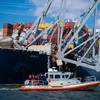For those convinced that the latest round of corporate consolidations is the last, think again. According to a new report from Drewry, the announcement by Keppel and Hitachi to further amalgamate the shiprepair industry in Singapore is the latest indication of a changing market structure through increased consolidation, diversification and an increased competitiveness from low cost emerging nations.
The intense competition prevalent within the industry is exemplified by the announcement of the two giant Singapore based conglomerates Keppel Corp. and Hitachi Zosen to merge their shiprepair and building activities in a $165-million deal, Drewry noted in "Shiprepair And Conversion: The Global Outlook." The merger gives Hitachi and Keppel interests of around 31 percent and 56 percent, respectively and heightens consolidation in the region as Sembawang and Jurong followed a similar path in 1997 effectively reducing the big four into two without reducing capacity.
The global shiprepair market experienced concentrated restructuring during the 1980s as yards responded to changing market conditions and trading patterns in line with ship owners. The 1990s have continued to follow this pattern with emphasis in Europe and the U.S. on downsizing operations or in certain cases complete withdrawal from commercial shiprepair. Elsewhere, emerging nations in Southeast Asia, China and the former Eastern Bloc have altered the market structure with investment in increasing and upgrading shiprepair facilities. Labor influences have also changed with a stronger emphasis on sub-contracted labor and pooling options to maximize efficiency through the tailoring of specific labor input into dedicated projects.
In the 1990s, it is estimated that shiprepair capacity based on dry-docks and floating facilities for vessels in excess of 10,000-dwt has changed its structure dramatically. In North Europe, capacity in deadweight terms has increased by 20 percent since 1990, while that in the Far East has risen by 70 percent (albeit that this includes an effective reclassing of existing facilities in Taiwan). Southeast Asia has witnessed 30 percent growth in repair facilities doubtless inspired by the aging tanker fleet. On the other hand there has also been a dramatic fall in capacity in North America - the 20 percent decline mainly on the eastern seaboard. Global dry-dock capacity has increased by around 12 percent - and although this is not out of context with the growth of the world fleet, it must be borne in mind that considerable fleet renewal has taken place and the age profile of the fleet has declined,
(and therefore by implication the demands for repair work).
Niche Players
From a yard perspective, the changing market structure has essentially driven the development of niche markets within the industry and certain opportunities will continue to arise. The emergence of dedicated facilities for the likes of cruise and ferry repairs is nothing new, however, the concentration is also evident in the form of large tanker repairs in which places such as the Middle East and Singapore are reliant.
Drewry's survey analyzes the markets and forecasts that geographic split in market share is set to alter again compounding the intense competition currently in the shiprepair business. North Europe, South Europe and North America are all forecast to lose ground. The majority of changes are likely to occur within regions as competition in traditional centers heightens. The Far East is expected to attain 11 percent of the global market share of revenue by 2003 with Southeast Asia growing by 1.7 percent by the same period.
As shiprepair revenue is unlikely to generate extraordinary gains on a per ship type basis, it would be natural to assume that geographical differences are also unlikely to see any radical movements. However, this is not necessarily the case as the high incidence of wide ranging capacity and competition within the market plus the elasticity of shipyard costs given such factors as exchange rates and outsourcing of labor has meant that certain regions have found themselves more competitive and achieved greater revenues.
Overall there has been little change in revenue per market share on a regional basis as significant competition and emerging markets have tended to come within regions. For example, a large proportion of the Far East market including Japan and South Korea has been eroded; however, China has in all probability captured the majority of that share.
Northern Europe has seen its percentage share of the global shiprepair market reduce in revenue terms with the loss of revenue attributable to widespread consolidation and restructuring of many former giants of the shiprepair world. Over the forecast period this share is again expected to fall further as the impact of lower cost economies in Eastern Europe and the Balkan states continue to attract for basic shiprepair requirements. However, it is expected that the fall in revenue will largely be stifled by the emergence of quality work in specific areas such as conversion work and those yards that have already begun to establish themselves in these markets are forecast to be the main beneficiaries. In addition, the strong anticipation of the high revenue generated by cruise vessels will help bolster totals for the region.
Southern Europe is somewhat akin to its northern counterparts where restructuring and a reduction of capacity has occurred in the more traditional centers. The outlook for Southern Europe according to Drewry is for a further loss of market share on a global basis given continued consolidation and a rationalization of capacity. Tanker work for which many of the yards in the Mediterranean were originally designed, has gradually diminished as the Middle East has come to dominate the business for tankers trading AG-Europe. However, the increasing competitiveness of the Black Sea yards for standard steel replacement jobs and Spain and Portugal's experience in the conversion sector, particularly offshore, suggests that the loss of market share in revenue terms will be less harsh than preliminary estimates might indicate.
Far Eastern yards are forecast to make significant strides in terms of market share as China's intention to expand facilities and utilize cheap resources will see them gain further market share from Japan and Singapore. It is anticipated that South Korea may make gains over the forecast period as a result of the economic crisis suffered by many of the shipbuilding yards. For instance, there has already been an inclination to develop their repair activities in the wake of reduced new vessel ordering at yards. The Koreans should also benefit from currency adjustments when competing for international business.
The Japanese share of market revenue is forecast to decline further overall as even its strong reliance on domestic work will be reduced following a lowering of R&M budgets from domestic operators.
Finally the Middle East is forecast to increase its market share through tough competition with the development of specialized projects such as gas and conversion work. The Middle East has been engaged in a fierce battle with its rivals in Singapore to become the prestigious number one center for large tanker repairs. By the end of 1997 many observers felt that this had been achieved through the large volume of stemmings for high profile tonnage. Given that they had a cost advantage of approximately three to five percent, however, the impact of relative currency advantages secured by the Singapore yards in recent months has brought them back in line.
Southeast Asia is also forecast to increase its percentage share of revenue with its ability to undertake steel replacement work or tank cleaning and coating at lower cost. With advantages secured through currency superiority, it is to be expected that international clients captured over the period will continue to call at these yards as long as cost and quality gains continue to be achieved.
The financial crisis suffered by the majority of Asian countries is likely to have an inverse effect on the shiprepair markets and actually prove a boon to shiprepairers as they take advantage of consistent exchange rate gains against the U.S. dollar, according to Drewry. Much of the work from domestic ship owners in the short to medium term will be lost as these owners will seek to reduce overheads at the expense of R&M budgets. However, Drewry predicts that growth will nevertheless remain positive and thus attract international owners in the wake of cheaper exports and thus increase the captive market share for shiprepairers in Southeast Asia.
Sponsored Content
Chris-Marine’s solutions help to prolong engine lifetime

AST is now AST Networks, bringing you remote connectivity wherever you are

March 2024
 Read the Magazine
Read the Magazine

 Read the Magazine
Read the Magazine
This issue sponsored by:

America’s Watershed Initiative: Sustaining a Critical Waterway
March 2024
 Read the Magazine
Read the Magazine

 Read the Magazine
Read the Magazine
This issue sponsored by:

Reagan National Defense Forum Highlights Uncrewed Maritime Systems
Subscribe for
Maritime Reporter E-News
Maritime Reporter E-News is the maritime industry's largest circulation and most authoritative ENews Service, delivered to your Email five times per week










